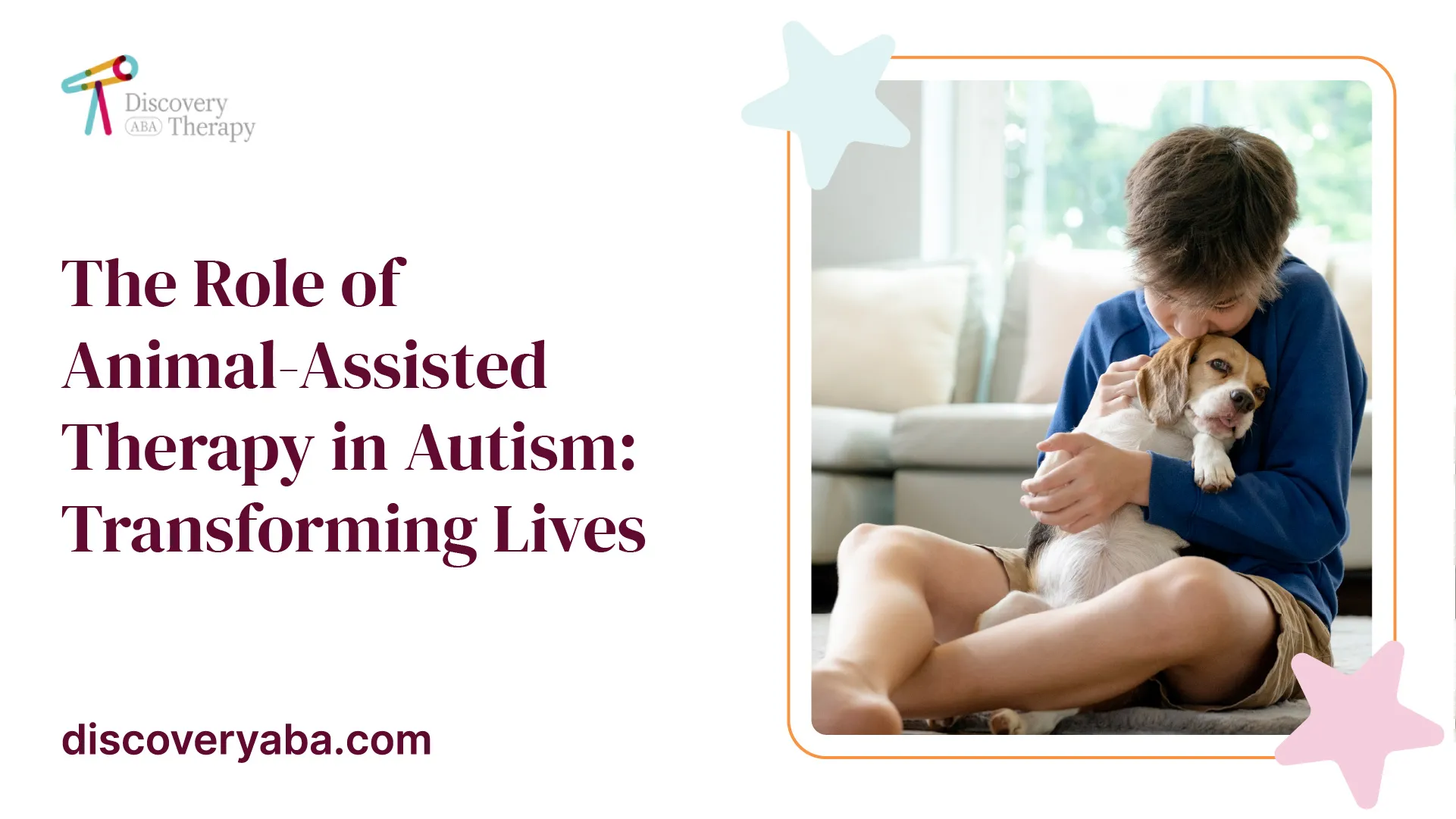The Role of Animal-Assisted Therapy in Autism: Transforming Lives
Discover the transformative power of animal-assisted therapy in autism. Unleash the potential for physical, emotional, and cognitive growth!

Animal-Assisted Therapy Benefits
Animal-assisted therapy (AAT) has gained recognition as an alternative approach for individuals diagnosed with Autism Spectrum Disorder (ASD). It is believed to provide a range of benefits, including physical, sensory, and emotional advantages [1]. Let's explore the various benefits that animal-assisted therapy can offer to individuals with autism.
Physical, Sensory, and Emotional Benefits
Animal-assisted therapy can have a positive impact on the physical, sensory, and emotional well-being of individuals with autism. Here are some key benefits:
- Physical Benefits: Interacting with animals during therapy sessions can contribute to improved physical fitness, strength, coordination, and focus for individuals with autism. The presence of animals can motivate individuals to engage in physical activities, such as walking or playing, which can enhance their overall physical health.
- Sensory Stimulation: Animals can provide unique sensory experiences during therapy sessions. The tactile sensations of petting or grooming an animal can offer individuals with autism valuable sensory input, potentially helping to improve sensory integration and regulation. The gentle touch and presence of animals can create a calming effect and reduce anxiety.
- Emotional Support: Animals are known to provide unconditional love, acceptance, and emotional support. Interacting with therapy animals can create a safe and non-judgmental environment, allowing individuals with autism to express their emotions and form emotional connections. Animals can serve as companions, offering comfort, empathy, and a source of joy for those with autism.

Cognitive and Behavioral Improvements
Animal-assisted therapy has shown positive trends in cognitive and behavioral domains for individuals with autism spectrum disorder (ASD). Here are some cognitive and behavioral benefits associated with animal-assisted therapy:
- Cognitive Improvements: Animal interaction can stimulate cognitive processes, such as attention, memory, and problem-solving skills. Engaging with therapy animals can provide opportunities for individuals with autism to practice cognitive tasks, enhance their focus, and improve cognitive flexibility.
- Behavioral Enhancements: Animal-assisted therapy has been linked to positive behavioral changes in individuals with autism. Interacting with animals can help reduce challenging behaviors, promote self-regulation, and increase prosocial behaviors like sharing, taking turns, and following instructions.
By incorporating animals into therapy sessions, animal-assisted therapy aims to support individuals with autism in various aspects of their lives. Whether it's through physical benefits, sensory stimulation, emotional support, or cognitive and behavioral improvements, the presence of animals can have a profound and positive impact on individuals with autism.
Animal-Assisted Interventions in Autism
Animal-assisted therapy (AAT) has emerged as a promising approach in supporting individuals with autism spectrum disorder (ASD). Numerous studies have shown positive trends in cognitive and social domains, making it an effective intervention for managing ASD symptoms and promoting overall well-being.
Positive Trends in Cognitive and Social Domains
Several randomized controlled trials have demonstrated the benefits of animal-assisted therapy for individuals with ASD. These studies have highlighted positive trends in various domains, including cognitive and social areas. A review of seven randomized controlled/clinical controlled trials found that AAT showed positive effects in the cognitive, social, emotional, behavioral, and physical domains for children and adolescents with ASD .
Animal interaction helps neurodivergent individuals engage more fully with others, develop confidence, independence, and communication skills . Research suggests that individuals with autism smile more when they are around animals, indicating the positive emotional impact of animal therapy. Animal therapy creates opportunities for social interaction, comfort, play, and joy, thus yielding significant benefits for individuals on the autism spectrum.
Managing Autism Spectrum Disorder
Animal-assisted interventions play a valuable role in managing autism spectrum disorder. They provide a non-judgmental and supportive environment that encourages individuals with ASD to engage socially and develop essential life skills.
Animal therapy has shown to improve physical fitness, strength, coordination, and focus for individuals with autism. Additionally, animal interaction can help individuals focus their attention more effectively. One study found that children with autism looked at dogs' faces longer than humans' faces, suggesting that animal therapy aids in developing focusing skills and increasing attention span.
By incorporating animal-assisted interventions into comprehensive treatment plans, individuals with ASD can experience improvements in cognitive functioning, social skills, emotional well-being, and overall quality of life. Animal therapy provides a unique and effective approach that complements traditional interventions, offering individuals with autism a chance to thrive and reach their full potential.
Animal Interaction Effects
Animal-assisted therapy (AAT) has demonstrated its potential to positively impact individuals with autism spectrum disorder (ASD), providing a range of benefits in various domains. Two significant areas where animal interaction can have a profound effect are enhancing social skills and communication, as well as fostering confidence building and independence.
Enhancing Social Skills and Communication
Animal-assisted therapy has shown promising results in enhancing social skills and improving communication among individuals with autism. Interacting with animals can create a safe and non-judgmental environment that promotes social engagement and interaction. Animals often serve as social catalysts, encouraging individuals with autism to initiate and maintain social interactions that they may find challenging with humans alone.
Studies have indicated that animal interaction helps neurodivergent individuals engage more fully with others, fostering shared interactions such as conversations and smiles. The presence of animals can reduce anxiety and facilitate communication, as individuals with autism often feel more comfortable and less inhibited in the presence of animals.
Confidence Building and Independence
Animal-assisted therapy has also shown to be effective in building confidence and fostering independence in individuals on the autism spectrum. Animals provide unconditional acceptance and support, which can boost self-esteem and self-confidence. Through interacting with animals, individuals with autism can develop a sense of competence and mastery, contributing to their overall confidence.
Engaging in activities such as caring for animals, walking dogs, or participating in equine therapy (hippotherapy) can enhance a sense of responsibility, independence, and self-efficacy. These activities require individuals to take on responsibilities and make decisions, promoting personal growth and independence.
Animal therapy has demonstrated positive effects on physical fitness, strength, coordination, and focus for individuals with autism. These improvements can contribute to an increased sense of confidence and independence in daily activities [2].
By incorporating animal interaction into therapy sessions, individuals with autism can experience valuable opportunities to develop social skills, improve communication, and gain confidence and independence. The unique bond formed with animals can create a nurturing and supportive environment that facilitates growth and positive behavioral changes.
Types of Animal-Assisted Therapy
Animal-assisted therapy (AAT) encompasses various approaches that utilize animals to enhance the well-being of individuals with autism. Two common types of animal-assisted therapy for autism are service dogs and emotional support animals.
Service Dogs for Autism
Service dogs have proven to be highly effective for children or adults with autism, as they provide a range of physical, emotional, and sensory support. These specially trained dogs assist individuals in navigating physical spaces, regulating emotions, and avoiding negative interactions. They also help curb meltdowns, aggression, self-harm, and can even protect against wandering into dangerous situations.
Service dogs for autism undergo professional training and certification to meet the unique needs of individuals on the autism spectrum. They provide a secure companion that can help promote a sense of calm and security. These dogs are legally allowed in public places and are commonly used as service animals for individuals with autism [2].
Emotional Support Animals for Stress
Emotional support animals offer valuable assistance to individuals with autism in navigating stressful situations. These animals, most commonly pets, provide comfort and support during travel, school, medical appointments, and other challenging experiences. Studies have shown that individuals with autism who have emotional support animals experience positive benefits from the companionship and emotional connection.
Unlike service dogs, emotional support animals do not require specialized training. They offer emotional support, comfort, and companionship to individuals with autism, helping them manage stress and anxiety. These animals can provide a calming presence and assist in promoting emotional well-being in various environments.
It is important to note that while service dogs and emotional support animals can be beneficial for individuals with autism, their suitability may vary depending on the specific needs and circumstances of each individual. Some parents find it challenging to manage the needs of children with autism and dogs simultaneously, even with highly trained dogs. It is crucial to consider individual capabilities and ensure that the presence of these animals aligns with the overall well-being of the individual and their family.
Diverse Animal Therapy Approaches
Animal-assisted therapy offers a range of diverse approaches to support individuals with autism. In this section, we will explore two specific approaches: hippotherapy with horses and pets as social bonds.
Hippotherapy with Horses
Hippotherapy, involving riding and taking care of horses, has shown to have numerous benefits for individuals with autism. This unique therapy approach supports physical, social, and emotional skills for those on the autism spectrum [3]. Interacting with horses during hippotherapy can have many physical benefits, such as improving balance, coordination, and muscle strength. Additionally, the rhythmic movements of the horse can help individuals with sensory sensitivities by providing sensory input and promoting sensory integration.
Beyond physical benefits, hippotherapy can contribute to social and emotional growth. Interacting with horses requires a level of communication and empathy, allowing individuals with autism to develop social skills and establish emotional connections with the animals. The bond formed between the individual and the horse can foster trust, self-confidence, and emotional regulation. Moreover, the serene and nature-filled environment of horseback riding can promote relaxation and reduce anxiety.
Pets as Social Bonds
Pets, such as dogs and cats, provide a unique social bond for individuals on the autism spectrum. Interacting with pets has been found to promote prosocial behaviors and foster shared interactions like conversations and smiles [3]. The presence of a pet can provide comfort and companionship, creating a sense of security and emotional support for individuals with autism.
One study even found that children with autism looked at dogs' faces longer than humans' faces, indicating that animal therapy can help individuals with autism focus their attention more effectively. In addition to emotional benefits, pets can also aid in physical exercise and promote responsibility. Taking care of a pet requires routines and practical skills, which can enhance organization and provide a sense of purpose for individuals with autism.
It's important to note that while service animals like dogs are professionally trained to meet specific needs and can provide a secure companion for individuals with autism in stressful situations, therapy animals and family pets have distinct roles. Service animals, such as dogs, can be legally allowed in any public place and are trained to assist with tasks and behaviors related to autism [2]. On the other hand, therapy animals offer comfort in medical and therapeutic settings but are not legally required access to all public places. However, both therapy animals and family pets can contribute to emotional and intellectual openness, communication, and overall well-being for individuals with autism.
Exploring diverse animal therapy approaches allows individuals with autism to engage and benefit from the unique qualities and interactions that these animals provide. Whether it's through the physical and social engagement with horses during hippotherapy or the emotional bond with pets, animal-assisted therapy offers a wide range of opportunities for individuals with autism to enhance their well-being and quality of life.
Considerations in Animal Therapy
When considering the use of animal-assisted therapy (AAT) in the context of autism, certain factors need to be taken into account to ensure the well-being of both therapy animals and individuals with autism. Two critical considerations in animal therapy are therapy animal welfare and research gaps for future studies.
Therapy Animal Welfare
The welfare of therapy animals in AAT is of utmost importance. Proper selection, training, and monitoring of therapy animals are crucial to ensure their well-being and prevent negative impacts [5]. The welfare of therapy animals involves providing them with appropriate living conditions, ensuring their physical and mental health, and recognizing the need for retirement when they reach an appropriate age or condition.
Therapy animals should undergo comprehensive assessments to determine their suitability for AAT. Ongoing monitoring and evaluation are necessary to ensure that therapy animals are not experiencing any undue stress or discomfort during sessions. Additionally, retirement plans should be in place to ensure that therapy animals can enjoy their golden years in a comfortable and appropriate environment.
Research Gaps and Future Studies
While animal-assisted therapy has shown promise in benefiting individuals with autism, further research is needed to understand its full potential and limitations. Larger and more defined studies are necessary to identify which individuals with autism will benefit most from this type of therapy. It is essential to have formal diagnosis, define therapy protocols, and clarify study outcomes when conducting research on animal therapy for autism.
Additionally, future studies should explore the effects of animal-assisted therapy on individuals with different developmental and psychiatric disorders. This broader scope would provide a more comprehensive understanding of the potential benefits and limitations of AAT in various contexts. It is also crucial to consider the perspectives of therapists and parents of children with autism to gain a more holistic view of the effectiveness and acceptance of AAT.
By continuously evaluating and expanding the research on animal-assisted therapy in the context of autism, we can gain deeper insights into its effectiveness, optimize therapeutic approaches, and ensure that individuals with autism receive the best possible care and support.
References
Does Your Child Have An Autism Diagnosis?
Learn More About How ABA Therapy Can Help
Find More Articles
Contact us
North Carolina, Nevada, Utah, Virginia
New Hampshire, Maine
Arizona, Colorado, Georgia, New Mexico, Oklahoma, Texas
.avif)




































































































